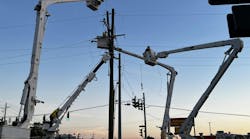Joe Rigby, chairman, president and CEO with PEPCO Holdings, welcomed the audience to the event and acknowledged the value of the upcoming merger between Exelon and PEPCO Holdings. He was also a participant in a panel following the session in which members were asked to help us “chart a course to a new energy future.”
Michael Howard, president and CEO of EPRI, kicked off the discussion by sharing EPRI's integrated grid initiative to shape the future of electricity. He stated that our power system will be much more dynamic, much less dispatchable and much more difficult to forecast.
"As we look forward, we will see the speed of innovation will at least triple," he said. Howard sees that a lot of changes are at the edge of the grid.
So what will the future look like?
The dynamic nature of the power system will require an integrated approach. Howard challenged the audience: “The innovations being developed by the people in this room will determine the power systems we will use in 2050.”
Terry Boston, CEO of PJM, then provided RTO and transmission perspectives, starting with this fact: PJM is the largest energy market in the world and represents 21% of GDP in the United States. Boston said that reliability is PJM’s number-one objective. He also shared that PJM generation is moving heavily toward gas and that today natural gas makes up 75% of the PJM fuel mix. Since 2005, the PJM environmental footprint has been reduced with significant reductions in NOx, Sox, and CO2.
PJM has also been affected by extreme weather: Irene in 2011 and Sandy in 2012. He was happy to report that during Sandy, transmission never became a critical factor. More than 65,000 tree and line workers were moved to the damage zones. “This was the largest mobilization in responder history.”
In the new energy market, PJM must address extreme weather. During the polar vortex, PJM had -20 degree temperatures in its service territory and set eight of 10 all-time PJM peaks during this extreme weather event.
Wind is coming in strong in PJM, and storage is coming right behind it. PJM has wind in place and 275 MW of storage in the queue.
PJM also has a real need for automatic frequency control to be delivered from wind and solar sources. Boston challenged the audience, “Let’s get an inverter standard. Otherwise we will have an upper limit on how much green we can integrate.”
He also stated the need more controllability and more HVDC to meet this need.
In conclusion PJM must focus on three things.
1) Keeping the lights on
2) Fair and efficient markets
3) Infrastructure for the the furure
Joe Rigby, chairman, president and CEO of PEPCO Holdings followed and kicked off with this comment: "We win or lose with customer satisfaction and this will require public and provate partnerships.
"The challenges we face are: Flat or declining demand curve, customer choice, politically sensitive state regulators, further penetration of DER and net metering, a cost recovery paradigm shift, cyber, physical and climatic shifts and stringent regulatory standards.
"AT PHI, we find that the ultimate value of the grid can be shown by the satisfaction of the customers after a severe weather event. We polled our customers and 66% said they expected power back within 6 hours after a severe weather event.
We are responding with automating sectionalizing and restoration. After two years, automatic service restoration has kept 13,000 customers from interruptions."
Rigby concluded the panel, stating that “We must ultimately communicate closely with policy makers and develop both public and private partnerships.”


